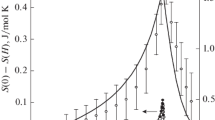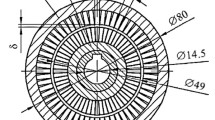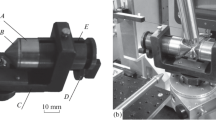Abstract
It is shown that the shape of a sample determines the allowed lower-bound limit of the coercive force of material that can be used for fabrication of magnets with the given shape. Rings with radial magnetization are used as examples to show that such samples can be made of only rare-earth alloys with the coercive force that is sufficiently high to satisfy technical requirements at the maximum allowed working temperature of the magnet.



Similar content being viewed by others
REFERENCES
K. J. Strnat, Y. Xiao, and H. F. Mildrum, J. Appl. Phys. 64, 5522 (1988).
W. Kappel, M. M. Codescu, and D. Popa, Rom. Rep. Phys. 56, 391 (2004).
S. Akbar, Z. Ahmad, M. S. Awan, M. Farooque, and A. Ali, Key Eng. Mater. 510–511, 507 (2012).
E. M. H. White, A. G. Kassen, K. W. Dennis, A. Palasyuk, R. W. McCallum, and I. E. Anderson, Int. J. Powder Metall. 52 (4), 33 (2016).
Permanent Magnets. Handbook, Ed. by Yu. M. Pyatin (Energiya, Moscow, 1971).
K. D. Durst, H. Kronmuller, and W. Ervens, Phys. Status Solidi A 108, 403 (1988).
V. V. Sergeev and T. I. Bulygina, Magnetically Hard Materials (Energiya, Moscow, 1980).
A. G. Gurevich, Magnetic Resonance in Ferrites and Antiferromagnetics (Nauka, Moscow, 1973).
R. J. Parker and R. J. Studders, Permanent Magnets and Their Applications (Wiley, 1962).
E. N. Kablov, Aviats. Mater. Tekhnol., No. 1, 3 (2015). https://doi.org/10.18577/2071-9140-2015-0-1-3-33
E. N. Kablov, O. G. Ospennikova, V. P. Piskorskii, I. I. Rezchikova, R. A. Valeev, and E. A. Davydova, Aviats. Mater. Tekhnol., No. S2, 5 (2015). https://doi.org/10.18577/2071-9140-2015-0-S2-5-10
E. N. Kablov, O. G. Ospennikova, I. I. Rezchikova, V. P. Piskorskii, R. A. Valeev, and D. V. Korolev, Aviats. Mater. Tekhnol., No. S2, 24 (2015). https://doi.org/10.18577/2071-9140-2015-0-S2-24-29
I. B. Kekalo and B. A. Samarin, Physical Metallurgy of Precision Alloys (Metallurgiya, Moscow, 1989).
E. N. Kablov, O. G. Ospennikova, I. V. Cherednichenko, I. I. Rezchikova, R. A. Valeev, and V. P. Piskorskii, Aviats. Mater. Tekhnol., No. S2, 11 (2015). https://doi.org/10.18577/2071-9140-2015-0-S2-11-19
Author information
Authors and Affiliations
Corresponding author
Additional information
Translated by A. Chikishev
Rights and permissions
About this article
Cite this article
Moiseeva, N.S., Rezchikova, I.I., Korolev, D.V. et al. Limitation of the Allowed Coercive Force Caused by the Scattering Field of Magnet. Tech. Phys. 64, 994–997 (2019). https://doi.org/10.1134/S1063784219070168
Received:
Revised:
Accepted:
Published:
Issue Date:
DOI: https://doi.org/10.1134/S1063784219070168




